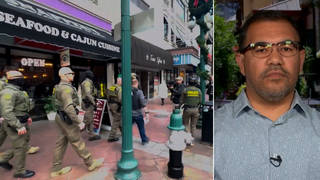
Guests
- Neta Crawfordprofessor of international relations at Oxford University and co-director of the Costs of War Project at Brown University.
With the 20th anniversary of the U.S. invasion of Iraq on March 20, we speak with Oxford University international relations professor Neta Crawford, who says the region is still reeling from the impact of the war. “The story continues. It’s not over,” she says. Crawford is co-director of the Costs of War Project at Brown University, where her latest report pegs the cost of U.S. wars in Iraq and Syria since 2003 at nearly $2.9 trillion. Since the U.S. invaded Iraq in 2003 under the false pretext of preventing Saddam Hussein from developing weapons of mass destruction, more than half a million people have been killed in Iraq and Syria. Millions more were displaced or died from indirect causes like disease. “It wasn’t quick, it wasn’t easy, and it certainly wasn’t cost-free,” says Crawford.
Transcript
AMY GOODMAN: This is Democracy Now!, democracynow.org, The War and Peace Report. I’m Amy Goodman.
As we continue to mark the 20th anniversary of the U.S.-led invasion and occupation of Iraq, we look now at the many costs of the war, from the civilian casualties to soaring Pentagon budgets, with Neta Crawford, co-director of the Costs of War Project at Brown University. She’s author of a new report titled “Blood and Treasure: United States Budgetary Costs and Human Costs of 20 Years of War in Iraq and Syria, 2003-2023.” She’s also professor of international relations at Oxford University and author of the new book The Pentagon, Climate Change, and War: Charting the Rise and Fall of U.S. Military Emissions. Today she’s joining us from Montreal, Canada.
Neta, welcome back to Democracy Now! If you can start off by laying out what you found as you looked at 20 years of U.S. invasion and occupation of Iraq? And I say going right through today, because thousands of U.S. soldiers are still in Iraq.
NETA CRAWFORD: That’s right. So, in 2002, the United States had a discussion about the costs of a possible war in Iraq and the possibility of civilians and others being harmed, and the estimates were then quite low. Between $50 billion and $200 billion or $300 billion would be the total cost of war. There would be few civilian casualties, few military casualties, and the war would be contained and over very quickly.
And what has happened over the last 20 years is that thousands of U.S. servicemembers were killed, about 5,000 U.S. servicemembers, and many contractors. And then, in addition, hundreds of thousands of civilians were killed — 7,000 by the U.S. in the first month of the war, but now hundreds of thousands of civilians were killed by all parties over the 20 years. And that’s in part because Iraq descended into civil war shortly after the U.S. invasion.
And then, in addition, many millions of people were displaced. Millions of people are still displaced internally and also as refugees in the region. Now, in Syria, the U.S. — when the U.S. intervened in 2014 into an ongoing Syrian civil war, many more people were displaced, many more people were injured by bombs.
And then, what we also see is that even in the places where the fighting has stopped, civilians and other people, like healthcare workers, have been injured by unexploded ordnance which has been left in the wake of the war. So the story continues. It’s not over. It wasn’t quick. It wasn’t easy. And it certainly wasn’t cost-free.
AMY GOODMAN: So, I want to ask you about the costs of war right now as we look at your report, which includes a table that shows more than 2,000 civilians were killed by U.S. coalition airstrikes in the first month of the Iraq War alone. Again, the U.S. invaded Iraq 20 years ago Sunday, our time Sunday. It was the 20th, March 20th, in Iraq, March 19th in the United States.
NETA CRAWFORD: That’s right. The U.S. began airstrikes actually before the war began, in a small number, but in the first month of the war, about 7,000 civilians were killed by all means by the U.S. coalition, more than 2,000 of them killed by airstrikes. And this was part of what was called then the “shock and awe” strategy. The idea was that if the United States bombarded Iraq, hit vital infrastructure and leaders, that the Iraqi military would collapse, that they would surrender. And, of course, that didn’t happen. But there were many civilians killed inadvertently by airstrikes that went astray. And this is always the case in war that civilians are harmed unintentionally. And then, of course, the airstrikes continued. But the first war was, in particular, quite intense — the first month of the war, in particular, quite intense.
AMY GOODMAN: So, 2,500 U.S. soldiers are still in Iraq. If you can talk more about what the U.S. is even requesting now? I mean, we’re talking about the U.S. returning to significant military operations in Iraq and Syria in late 2014 in fighting that was undertaken, they said, to remove Islamic State from the territory. The war continues with a nearly $400 million budget request from the Biden administration this month to counter ISIS, they say.
NETA CRAWFORD: That’s right. The United States believes that if they leave, ISIS or some other militants will come back. And right now the idea is to maintain a presence there on the border, and also in Syria, to make sure that ISIS cannot recover and take more territory.
Now, of course, in the period after the invasion, there were no militants, terrorists in Iraq. And that’s what we knew then, that the reason for the war in 2003 was to supposedly get rid of weapons of mass destruction, which were not there and never found, of course, because they had already been dismantled. But ISIS and other militants flocked to Iraq in part to push back the United States coalition and to try to free Iraq from what they saw as a foreign occupation. And so, the birth of ISIS is in part due to the U.S. invasion in 2003. And, of course, ISIS spread in the region and took over large swaths of territory, which then had to be retaken. And it was a very intense fight. So, the United States remains there to do that at, as you say, a requested nearly $400 million for next year.
AMY GOODMAN: Professor Crawford, why did you include Syria in the costs of war with Iraq?
NETA CRAWFORD: Well, quite simply because when ISIS took this territory, they didn’t take it just in Syria, they took it in Iraq. The reason why President Obama said the United States needed to be in this fight was because the democracy that the United States hoped to set up and support in Iraq, the government there was at risk. Large parts of the territory near Syria were taken. So the United States began bombardment of ISIS, and so did other countries, and tried to take that territory back. Of course, they destroyed much of what had been rebuilt following the 2003 invasion. And this is why it’s included, because it’s of a piece. The entire war effort is premised on fighting — post-2014, is premised on fighting ISIS, which was in both countries. And it’s called Operation Inherent Resolve, and that’s the point. It is about Syria and Iraq.
AMY GOODMAN: And finally, your new book, The Pentagon, Climate Change, and War: Charting the Rise and Fall of U.S. Military Emissions, relate it directly to Iraq.
NETA CRAWFORD: No, well, the rise and fall of U.S. military emissions, The Pentagon, Climate Change, and War is about U.S. military emissions from the 19th century to the present. But the part of the emissions from the Iraq War, I calculate to be about 100 million metric tons from 2003 to the present.
AMY GOODMAN: Right. And we have 15 seconds, but —
NETA CRAWFORD: Hundred million metric tons CO2.
AMY GOODMAN: — the connection between climate change and a war for oil?
NETA CRAWFORD: Well, it takes fuel to fight, and the fight for fuel has been a large part of United States military doctrine and U.S. foreign policy since the 1980s. The idea is to make sure that the fuel is available. And in part, it’s so that it’s available for warfare.
AMY GOODMAN: Professor Crawford, we’re going to do Part 2 and post it online at democracynow.org. Neta Crawford, professor of international relations at Oxford University, co-director of the Costs of War Project at Brown University. We’ll link to your new report, “Blood and Treasure.” I’m Amy Goodman. Thanks for joining us.











Media Options